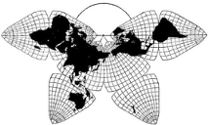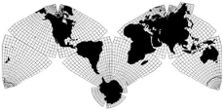
Cahill 1909

Cahill-Keyes 1975

Cahill 1909
|
Go back to
Gene Keyes home page
Cahill-Keyes 1975 |
|
Why Cahill? What about Buckminster Fuller?
Evolution of the Dymaxion Map: An Illustrated Tour and Critique Part 4 by Gene Keyes 2009-06-15 Summary: I love
Bucky, but Cahill's map is a lot better. Here's how.
CONTENTS Click inside boxes to open other sections in separate windows. |
|
Part 4
Buckminster Fuller's 1946 Cartography
Patent
Enlarged and presented by Gene Keyes in two formats
Another frequent misstatement by Fuller et al
is that this was the first American patent for a map projection; but
Cahill
had patented the octhedral projection in 1913. Nevertheless, the
Fuller patent is seminal in its own right, being a forerunner to his
invention of the geodesic dome.
I am reproducing this one in two formats: 1) the pdf itself directly on this website, without the Flash and clutter of Google Patent Search; 2) Jpegs enlarged to 125% of the pdf's hard-to-read fine print; (You might be right to assume that I am not a fan of pdf, and not a fan of tiny print, whether on paper or computer screens. These easier-to-read versions are presented with my compliments, even though I have some bones to pick with the Dymaxion map.) |








|
|
Though illustrating the cubo-octahedron, Fuller
had written the patent to apply to other polyhedra, such as the icosahedron.
However, he rejected that 20-facet figure until 1954, when his "Raleigh"
edition of the Dymaxion map appeared in its now familiar form.
|